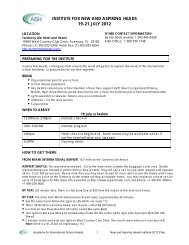AISHnet Survey - Academy for International School Heads
AISHnet Survey - Academy for International School Heads
AISHnet Survey - Academy for International School Heads
You also want an ePaper? Increase the reach of your titles
YUMPU automatically turns print PDFs into web optimized ePapers that Google loves.
1:1 Laptops in the Classroom—Where Are We Now?<br />
22/3/11 4:28 PM<br />
The article asserts that indeed, the success of a 1:1 laptop program rests in the preparation and teaching<br />
strategies of the teacher in the classroom, pulling together findings from a variety of sources, including The<br />
Journal of Technology, Learning, and Assessment, published by the Boston College Lynch <strong>School</strong> of<br />
Education, January 2010 special edition devoted to the 1:1 laptop issue.<br />
Researchers Damien Bebell and Laura O’Dwyer assert that the downfall of 1:1 laptop programs is the<br />
assumption that simply giving a student a laptop is the magic bullet because there is little focus on the<br />
education process.<br />
“[The program] refers to the level at which technology is available to students and teachers; by definition, it<br />
says nothing about actual educational practices,” they write in “Educational Outcomes and Research from<br />
1:1 Computing Programs.”<br />
Bebell, with Rachel Kay, conducted a study of five Western Massachusetts public and private middle<br />
schools that participated in the Berkshire Wireless Learning Initiative. What they found was that the 1:1<br />
laptop program had positive educational effects, but educational practices changed as well. Teachers had<br />
to change their methods of instruction.<br />
“One of the central project outcomes of the study was the documentation of fundamental changes in<br />
teaching, particularly teaching strategies, curriculum delivery, and classroom management,” write Bebell and<br />
Kay. “Without question, the 1:1 program had major impacts across many aspects of teaching <strong>for</strong> the<br />
majority of teacher participants.”<br />
In the Philadelphia area, Lower Merion High <strong>School</strong> has been conducting a 1:1 program, while nearby<br />
Harriton High <strong>School</strong> is three-years in. In January, the Lower Merion <strong>School</strong> District’s Supervisor of<br />
Instruction Technology told the <strong>School</strong> Board that education delivery and practices in those schools were<br />
allowing students to reach new levels of learning.”<br />
As reported by the Ardmore-Merion-Wynnewood Patch Hilt noted that the district uses a method called<br />
SAMR (Substitution, Augmentation, Modification, and Redefinition), which firsts asks teachers to substitute<br />
technology <strong>for</strong> resources or established instructional practices. The goal, though, is to next use the<br />
technology to augment lessons to provide additional advantages and then modify lessons based on the<br />
advanced technology available through the program. Ultimately, 1:1 computing should redefine educational<br />
practices. Teachers become the moderators and facilitators of a wider world of learning.<br />
Lower Merion Spanish Teacher Allison Mellett and Biology teacher Elliott Burch have embraced 1:1<br />
computing <strong>for</strong> their classes. Burch, <strong>for</strong> example, asked students to demonstrate animal behaviors by<br />
producing claymation movies using their laptops’ built-in cameras and iMovie software rather than write<br />
written reports. Mellet has a virtual classroom model—students download class assignments and upload<br />
their completed work. Her classroom is completely paperless.<br />
The concept is in line with the 21st Century <strong>School</strong>s concept, which is the hot topic in education re<strong>for</strong>m<br />
right now.<br />
A teacher at the Wichern-Schule in Hamburg, Germany, Torsten Otto agrees that it is up to the teacher and<br />
his/her practices <strong>for</strong> the 1:1 computing model to fulfill its promise.<br />
“In our 1-to-1 program … we put a big emphasis on project-based learning; otherwise, the laptop is no<br />
more than an expensive notepad. Research needs to show the effects of this different style of teaching in<br />
terms of student engagement, motivation, and so-called 21st-century skills,” Otto said in the e<strong>School</strong> News<br />
story.<br />
In Lower Merion, four students lauded the program at the <strong>School</strong> Board meeting. Harriton Senior Daniel<br />
Carp said “ I keep everything I need <strong>for</strong> school on my computer. I can connect with students and teachers,<br />
and any pressing question I might have can be answered with a quick e-mail.”<br />
But a survey of parents and students show that not everyone is enamored with 1:1 computing and the<br />
laptop program. The Merionite, Lower Merion student newspaper, conducted a student survey that showed<br />
http://isminc.com/index.php?view=article&catid=1005%3Avol-9-no-6…ent&print=1&layout=default&page=&option=com_content&Itemid=1218<br />
Page 2 of 3



